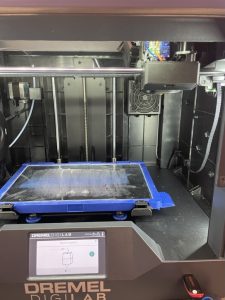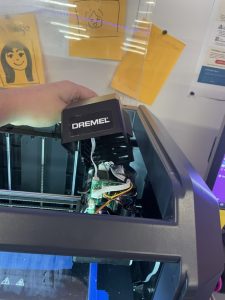Picture this: You have a hard time deciding what you want to print at The Williams Makerspace, you talk to your friends to brainstorm the best possible artifact, and just when you finally decide to print your so-awaited masterpiece, you find out that the 3d printer is broken. This not-so-uncommon outcome can be disappointing. Though, as a student worker at The Williams Makerspace, I can tell you that this is totally normal! One of the reasons for this happening might be that the 3D printer is clogged. In this blog post, I will talk about my experience unclogging a Dremel DigiLab 3D45 for the first time.
First things first — purging the filament! At this stage, we don’t know what might be causing the clogging, so purging the filament is a safe start. To do so, we cut the filament and press the “Purge” button on the preheating option section. Once clicked, the Dremel should start purging all the filament out, cleaning the inside.
Figure 1. Purging the filament

Unfortunately, purging the filament didn’t fix the issue in this case, so I had to go a little further! To ensure there were no clogs in the stepper motor, I had to turn the Dremel off and allow the extruder and print bed to cool to at least 60°C. Then, I removed the right screw on the bottom of the housing using a T10 Torx bit. From there, I removed the two screws on top of the extruder housing using a 2.5mm hex bit. At this point, I removed the top cover and unplugged the filament runout switch to disconnect the extruder terminal box. I unscrewed – but not entirely – the two motor screws using a 2.5mm Allen key. This allowed me to remove the extruder stepper motor assembly. Taking a clean brush, I gently cleaned the motor as carefully as possible and then put everything back in place. And just like that (drum roll, please), the Dremel DigiLab 3D45 was unclogged!
Figure 2. Taking the cover off

I know this might sound like a lot at first — because it is! But as you get used to working with 3D printers, you will encounter this and many other problems on your way — so beware! For me, one of the best parts of working with these kinds of machines is learning how to use them and fix them! So, the next time you walk into the Williams Makerspace, be assured that we will guide you through any questions or concerns about 3D prints or 3D printers. The best part is that if we don’t know the answer at the top of our heads, we will do our best to answer it as soon as we can.
